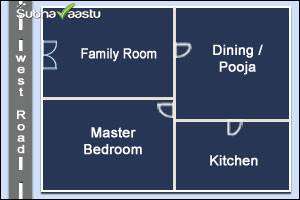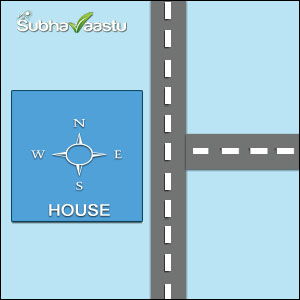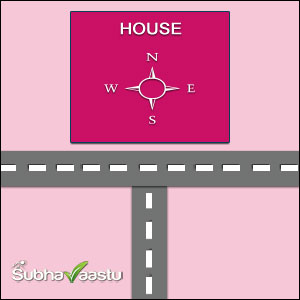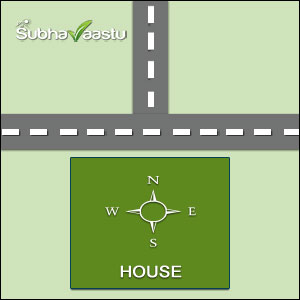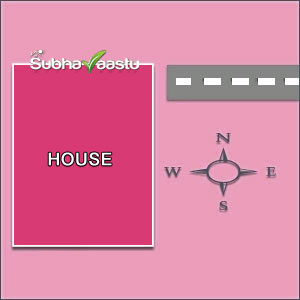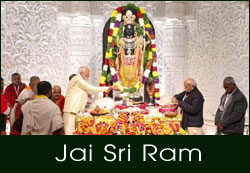- Details
- Total Views for This Page: 267396
Exploring Indian Vastu Shastra - India's Timeless Architectural Wisdom
 This website highlights the timeless wisdom of India's Vastu Shastra. In this article, we discuss its foundational principles, historical roots, renowned contributors, and how this ancient architectural science has evolved through the ages.
This website highlights the timeless wisdom of India's Vastu Shastra. In this article, we discuss its foundational principles, historical roots, renowned contributors, and how this ancient architectural science has evolved through the ages.
Sloka: The Invocation to Vastu Purusha
In Vastu Shastra, every discussion begins with a "Sloka", a sacred Sanskrit verse. This prayer is an invocation to Vastu Purusha, the divine cosmic energy believed to reside in every piece of land and structure. Reciting this Sloka is considered auspicious as it seeks blessings from the deities of all eight directions along with Vastu Bhagavan, ensuring peace, prosperity, and protection for the inhabitants of the space.
OM VASTU DEVAM MAHAKAYAPANCHA BOOTHA ASHTA DHISHIM INDHRAE SARVA NAYAKA AAGNEYE USHANA KAARANAMDHAKSHINE KAALA RUPINAMNAIRUTHE VISARJANATHAMPASCHIME AAPA NAATHAMVAAYAVYE PRANA KAARANAMUTHTHARE AISHWARYAANTHUEESHANYE LOKA KAARANAMMADHYAME PEEDINAM BHOOMIMMAHADEVAM MAHODHBHAVAMSARVA LOKA MAYAM DEVAMVASTU DEVAM NAMOSTHUTHE.
Commentary: Understanding the Deeper Meaning
The Commentary provides a simple explanation of the Sloka. It describes how "Vastu Bhagavan" occupies the center of the space, surrounded by the guardians of the eight directions. Each deity governs a direction and contributes a unique influence, such as health, wealth, protection, or spiritual growth. By acknowledging these divine forces, Vastu Shastra emphasizes harmony between human dwellings and natural energies. The commentary helps readers connect the spiritual meaning of the Sloka with the practical principles of Vastu in daily life.
1. Vastu Bhagavan: Sri Vastu Bhagavan, also called Vastu Purusha, is regarded as the God of Earth with a cosmic body representing eternal nature. He occupies the central position while being surrounded by the lords of the eight directions.
2. Lords of Directions: Ancient texts describe the guardians of each direction: - East (Poorva): Lord Indra - Southeast (Agneya): Lord Agni - South (Dakshina): Lord Yama - Southwest (Nairuthi): Lord Niruthi (Rakshasa) - West (Paschima): Lord Varuna, the Rain God - Northwest (Vayavya): Lord Vayu, the Wind God - North (Uttara): Lord Kubera, the God of Wealth - Northeast (Eshan): Lord Ishana or Lord Shiva
3. Spiritual Significance: Vastu Purusha is seen as the energy behind all growth and manifestation hidden within the Earth. By offering prayers to Vastu Bhagavan, one seeks blessings of peace, prosperity, and success.
Eight Directions and Their Lords:
1. East Direction – Indra
2. Southeast Direction (Agneya) – Agni
3. South Direction – Yama
4. Southwest Direction (Nairuthi) – Niruthi
5. West Direction – Varuna (Rain Lord)
6. Northwest Direction (Vayavya) – Vayu (Lord of Air)
7. North Direction – Kubera (Lord of Wealth)
8. Northeast Direction (Eshan) – Ishana / Lord Shiva
Benefits of Living in a Vastu-Compliant Home:
1. Better living conditions, with good health, stability, and happiness.
2. Enhanced reputation in society and neighborhood.
3. Increased prosperity and peace of mind by reducing internal conflicts.
4. Greater success in professional and personal endeavors.
5. Clear thinking and focused approach to solving problems.
6. Fulfillment of genuine desires and life goals.
7. Ability to overcome difficulties with harmony.
8. Living a contented and balanced life.
9. Rational and positive mindset when living in a principled home.
10. Completion of tasks with less stress and reduced anxiety.
11. Avoidance of negative vibrations that disturb clarity and judgment in non-compliant homes.
12. Harmony within the family by reducing quarrels and misunderstandings.
13. Supportive environment for good actions, while discouraging negative tendencies.
Conclusion: A home constructed with Vastu principles helps enhance peace, prosperity, and harmony. Conversely, residences that ignore these principles may create stress, conflicts, and doubts in the minds of the residents. Following this ancient wisdom ensures balance between human life and nature’s forces.
The Lords of Eight Directions According to Vastu Shastra
| Direction | Ruling Deity | Attribute |
|---|---|---|
| East | Indra | Lord of Rain and Thunder, represents power and growth |
| Southeast (Agneya) | Agni | God of Fire, represents energy and transformation |
| South | Yama | God of Death, symbolizes discipline and justice |
| Southwest (Nairuthi) | Niruthi | Guardian of Stability, linked with protection and strength |
| West | Varuna | Rain Lord, represents water, wisdom, and control |
| Northwest (Vayavya) | Vayu | Lord of Air, represents movement and communication |
| North | Kubera | God of Wealth, symbolizes prosperity and abundance |
| Northeast (Eshan) | Ishana / Lord Shiva | Represents spiritual growth, knowledge, and divinity |
Free House Floor Plans
Benefits of Living in a Vastu-Compliant Home
| Problem in Life | How Vastu Helps | Result / Benefit |
|---|---|---|
| Health issues, stress, lack of vitality | Ensures proper light, ventilation, and energy balance | Improved health, vitality, and peace of mind |
| Financial struggles, debts, instability | Aligns spaces to attract prosperity and opportunities | Wealth growth, financial stability, and abundance |
| Family disputes and misunderstandings | Balances directions to reduce negative influences | Harmony, stronger relationships, peaceful home life |
| Stress, anxiety, confusion in decision-making | Encourages clear energy flow and positivity | Calmness, focus, and confident decision-making |
| Lack of recognition or poor reputation | Promotes favorable directional alignment | Good reputation, respect, and social acceptance |
| Obstacles in career or personal goals | Corrects imbalances in construction and layout | Progress in career, success, and fulfillment |
| Constant stress and negativity at home | Neutralizes harmful vibrations and enhances positivity | Contentment, peace of mind, and positive outlook |
| Unhappiness despite wealth and luxury | Emphasizes inner peace beyond material comforts | Balanced, happy, and meaningful life |
Eight Directions, Their Lords, and Benefits in Vastu Shastra
| Direction | Ruling Deity | Associated Attribute | Positive Benefits in Vastu |
|---|---|---|---|
| East | Indra | Power, growth, and vitality | Good health, reputation, and overall progress |
| Southeast (Agneya) | Agni | Energy, fire, and transformation | Wealth, enthusiasm, and success in business |
| South | Yama | Discipline and control | Longevity, stability, and protection |
| Southwest (Nairuthi) | Niruthi | Strength and foundation | Family security, financial strength, stability |
| West | Varuna | Water, wisdom, and control | Spiritual growth, social connections, opportunities |
| Northwest (Vayavya) | Vayu | Movement and communication | Strong relationships, better networking, travel luck |
| North | Kubera | Wealth and abundance | Financial prosperity, career growth, savings |
| Northeast (Eshan) | Ishana / Lord Shiva | Spirituality, purity, and knowledge | Peace of mind, wisdom, spiritual development |
Road Thrust Information
What is Vastu Shastra?
1. Understanding the Meaning: Just as words are defined to express their essence, in the same way we need to understand what Vaastu truly represents. This ancient science is closely linked with “peace of mind,” where residents experience harmony, prosperity, and well-being while living in a home designed according to its principles.
2. Beyond Wealth: Many people assume that money is the ultimate solution for every problem. Yet, life proves otherwise. Priceless aspects such as a mother’s love or genuine happiness cannot be purchased with wealth. Vastu Shastra reminds us that inner peace and contentment are far more valuable than material possessions.
3. Origin of the Word: According to ancient literature, the word “Vastu” comes from “Vasathi” or “Vaasa,” meaning a dwelling or residence under one roof. Over time, this term evolved into the present-day word Vastu. In Bengal and some other regions, it is also written as Bastu or Baastu, while in different parts of the world it appears as Vastu, Vaastu, Vasthu, or Vaasthu. (This matter is from www.subhavaastu.com). Despite differences in spelling, the meaning remains the same everywhere.
4. The Core Science: Traditionally, this discipline is called Vastu Shastra. At its foundation, it is the science of designing spaces that foster peace, satisfaction, balance, and overall development. Nothing in life can equal the value of true peace of mind.
5. The Priceless Gift of Peace: Observations show that even wealthy individuals may lack peace of mind. This highlights how precious and limitless inner peace truly is. The influence of Vaasthu is directly associated with harmony and balance for those who follow its principles.
6. Relief Through Vastu: Individuals struggling with health issues, financial troubles, debts, family conflicts, court cases, misunderstandings, or stress often turn to Vastu. Many find that applying these principles helps restore peace, stability, and happiness in their lives.
7. Attaining Fulfillment: Homes or properties designed in accordance with Vastu Shastra principles are believed to provide comfort, prosperity, and satisfaction to their residents. Those who adopt this science in their construction practices often achieve their desired goals and lead a more fulfilling life.
8. Learn More: To explore this subject in greater depth, we invite you to visit the other sections of our website, which provide a wide range of detailed information and insights into Vastu Shastra.
Street Focus Information
Who Invented Vastu Shastra? A Journey Into Its Ancient Beginnings
1. The Question of Authorship: When people ask, "Who wrote Vastu Shastra?", most references highlight Mamuni Mayan, while some traditions also give credit to Vishwakarma. Both are considered key figures in the evolution of this ancient discipline.
2. The Science of Architecture: Vastu Shastra is an ancient Indian system of architecture that provides principles for designing spaces in alignment with natural forces. Its ultimate goal is to promote health, prosperity, and happiness for the residents. Often described as the science of architecture, its roots can be traced back to Indian scriptures, especially the Atharva Veda.
3. Multiple Sources of Origin: The beginnings of Vaastu are complex and cannot be attributed to a single author. Over centuries, many sages and scholars contributed to its growth. Among the most respected texts are the Mayamata and Manasara, which provide detailed insights into Vastu principles.
4. Contribution of Mamuni Mayan: Historical traditions often honor "Mamuni Mayan", also known as "Maya Brahma", as a central contributor to this science. Earlier texts even referred to the subject as "Maya Vastu" OR "Mayamatam", highlighting his profound influence.
5. Role of Vishwakarma: In Hindu belief, "Viswakarma" is regarded as the divine architect of the universe. Many consider him to be a symbolic father figure of Vastu knowledge, guiding principles that shaped sacred spaces and dwellings.
6. Reference to Lord Brahma: Some scriptures also describe Lord Brahma as the original source of Vastu Shastra, portraying him as the one who imparted this wisdom to sages and architects for the benefit of humanity.
7. Enduring Legacy: Although its origins are attributed to different figures, Vastu Shastra continues to shine as a timeless body of knowledge, offering guidance for balanced living and serving as a symbol of harmony, wisdom, and positive energy across generations.
Ancient Indian Vastu Shastra: Wisdom Behind Sacred Spaces
1. Ancient Origins: Since ancient times, during the glorious era of monarchs and mighty rulers, Vastu Shastra was a highly valued doctrinal science. It was predominantly practiced by the wealthy and influential. Unlike today’s easy access to knowledge, in those times information was guarded and shared only among the privileged.
2. Exclusivity of the Rich: It was mainly the kings, landlords, and the affluent who had the resources to harness this wisdom. They used it to safeguard their prosperity, strengthen kingdoms, and expand territories. Sadly, the underprivileged and marginalized classes remained unaware of this powerful system.
3. Shift Towards Democracy: As ages passed, monarchies declined and democratic principles began to flourish across nations. With this change, every individual gained the liberty to explore, learn, and implement knowledge. Vastu Shastra, once reserved for elites, gradually became accessible to everyone, irrespective of status or wealth.
4. A Unique Science of Construction: Unlike conventional civil engineering, Vastu Shastra is not just about physical structures. It views every construction, be it residential or commercial, as a living entity composed of both positive and negative energies. The real essence lies in balancing these forces to create harmony, prosperity, and peace.
5. Benefits of Vastu Shastra: The ancient traditional system of Indian Vastu Shastra holds the power to influence human well-being on multiple levels. Its disciplined approach provides a comprehensive framework for design, layout, and alignment with natural elements.
6. Vast Applicability: This knowledge is not confined to homes alone. It extends to offices, industries, educational institutions, and even temples. Wherever applied, Vastu Shastra helps create nurturing spaces that empower life and invite balance.
Conclusion: Ancient Indian Vastu Shastra is far more than a set of construction guidelines, it is a holistic philosophy that transforms ordinary structures into powerful spaces of growth, balance, and prosperity.
Discover the Advantages of Following Vastu Shastra
Vastu Shastra offers a wealth of benefits that touch every aspect of human life, from mental peace to material prosperity. By aligning spaces with natural forces, it ensures an environment that nurtures balance and positivity.
1. Mental & Emotional Harmony: Optimizing the flow of energy in a home creates a peaceful atmosphere, reducing stress and improving focus, concentration, and overall well-being. Families often notice stronger bonds and healthier relationships.
2. Physical Health: Vastu-based designs emphasize natural light, ventilation, and spatial balance, which directly contribute to good health, vitality, and restful sleep.
3. Financial Prosperity: Specific layouts and directional alignments are believed to attract wealth, growth opportunities, and financial stability, making prosperity more attainable.
4. Spiritual Growth: Living in a space designed with Vastu principles fosters inner peace and supports spiritual development by harmonizing the individual with nature.
5. Holistic Lifestyle: Ultimately, Vastu Shastra offers a comprehensive path to a balanced, prosperous, and fulfilling life. Its relevance extends beyond houses, guiding the design of offices, businesses, and institutions as well.
At our website, we proudly present the Benefits of Vastu Shastra: A Comprehensive Guide, a resource created for our beloved readers to unlock the timeless wisdom of this ancient science.
Associated Vastu Links
Ancient Indian Vastu Shastra: Secrets of Balance and Prosperity
 1. Optimize Your Living Space with Vastu Shastra Wisdom: Since the dawn of civilization, humanity has been in search of the ultimate sanctuary, a home that nurtures both body and soul. In ancient times, visionary ancestors applied indigenous techniques to create dwellings that were not just physical structures but true sanctuaries of balance, peace, and well-being. Through the timeless knowledge of Vastu, they designed living spaces aligned with cosmic harmony and natural forces.
1. Optimize Your Living Space with Vastu Shastra Wisdom: Since the dawn of civilization, humanity has been in search of the ultimate sanctuary, a home that nurtures both body and soul. In ancient times, visionary ancestors applied indigenous techniques to create dwellings that were not just physical structures but true sanctuaries of balance, peace, and well-being. Through the timeless knowledge of Vastu, they designed living spaces aligned with cosmic harmony and natural forces.
2. In the present day, we continue to explore the intricacies of Vastu Shastra principles, tracing their origins and recognizing the contributions of great authors from classical texts. Historically, many Vastu consultants were known, yet communication barriers made it difficult to seek their guidance from distant locations.
3. Today, with global connectivity, residents from the USA, United Kingdom, Australia, Singapore, and Malaysia can easily reach out, clarify their questions, and even invite experienced Vastu pandits for direct property visits.
Essential Vastu Links to Visit
What Is Vastu Shastra Called in English?
Vastu Shastra does not have an exact synonym in English. It is universally referred to by the same name, preserving its originality and authenticity. Some people interpret it as the "Science of Architecture", yet the original Sanskrit term continues to be respected and recognized across the world. This timeless name, Vastu Shastra, remains immortal as the symbol of ancient construction wisdom from the Indian subcontinent.
Four Vedas : Pride of India : India’s Greatest Gift to Humanity
| Veda | Meaning | Main Focus | Importance |
|---|---|---|---|
| Rigveda | “Veda of Hymns” | Prayers and hymns dedicated to deities | Oldest Veda, foundation of Vedic knowledge |
| Yajurveda | “Veda of Rituals” | Instructions for yajnas and sacrifices | Guides rituals, discipline, and order in worship |
| Samaveda | “Veda of Chants” | Musical hymns and melodies | Origin of Indian classical music, role of sound in spirituality |
| Atharvaveda | “Veda of Everyday Life” | Prayers for health, peace, and protection | Practical wisdom for daily living, healing, and prosperity |
Together, these "Four Vedas" are considered the greatest literature on Earth, offering timeless knowledge on spirituality, rituals, music, philosophy, and harmonious living.
Components of the Vedas
The Vedas are not single books but vast collections of knowledge composed of different sections, each serving a unique purpose. Traditionally, the Vedas are understood to consist of the following parts:
1. Samhitas: Collections of hymns and mantras dedicated to various deities, mainly used in prayers and rituals.
2. Aranyakas: Texts dealing with rituals, sacrifices, and ceremonies, often intended for forest-dwelling sages who practiced them away from the bustle of society.
3. Brahmanas: Prose texts that provide detailed explanations, commentaries, and symbolic interpretations of Vedic rituals and sacrifices.
4. Upanishads: Philosophical works that explore meditation, spirituality, self-realization, and the deeper meaning of existence. They are often considered the crown of Vedic wisdom.
5. Upasanas: Texts focused on methods of worship, devotional practices, and meditations.
The Puranas and Their Divisions
It is difficult to determine the exact dates of composition for the Puranas. However, over time, 18 Mahapuranas were compiled and categorized into three groups of six each, totaling eighteen. These texts are named after major deities such as Brahma, Vishnu, and Shiva. For example: Brahma Purana, Vishnu Purana, and Shiva Purana.
Orthodox and Heterodox Traditions
Traditionally, followers of the Vedas are called Āstikas (orthodox), while those who reject the authority of the Vedas are called Nāstikas (heterodox). Even those who initially doubted the Vedas, upon studying them, sometimes turned into firm believers.
The Āstika schools of Indian philosophy (Nyaya, Vaisheshika, Samkhya, Yoga, Mimamsa, and Vedanta) cite the Vedas as their ultimate authority. In contrast, Shramana traditions such as Charvaka, Lokayata, Ajivika, Jainism, and Buddhism do not consider the Vedas as authoritative.
Timeless Influence of the Vedas
The Vedas hold an unmatched position in Indian philosophy. They have been referenced as scriptural authorities for centuries and played a significant role even during the BC periods of Indian history. To this day, scholars continue to engage in deep discussions and analyses of the Vedas, highlighting their everlasting influence and wisdom.
Vastu Shastra Literature
1. When it comes to Vastu Books and their authors, India has been blessed with many great personalities who shared their profound wisdom, passing this ancient knowledge down through generations.
2. Before exploring the details of these books, it is meaningful to understand a little about the "Vedas" and other sacred scriptures, which form the foundation of Indian tradition and spiritual thought.
3. Our elders often say that the Puranas are the guiding literature of Hindu Dharma. Among them, Veda Vyasa, the great sage and narrator of the Mahabharata, is revered as the compiler and master of the Puranas.
4. It was Vyasa who classified the vast body of Vedic knowledge into four parts, and thus came to be known as "Veda Vyasa". The word Veda itself means "Jnana," or supreme knowledge and wisdom. Veda Vyasa was the son of the sage Parashara Maharshi.
5. Tradition holds that there were originally around 64 Puranas. Out of these, 18 are recognized as the Mahapuranas, 18 as the principal Upa Puranas, while the remaining belong to the wider group of Upa Puranas.
Historical and Classical Literature on Vastu Shastra
Vastu Shastra has a long and rich literary tradition. Many classical works, composed over centuries, serve as the primary sources for Vastu theory and practice. Below is a concise, fact-checked overview of the most important treatises and related works frequently cited by scholars and practitioners.
Viśvakarma Vastuśāstra / Prakāśika: Attributed to the divine architect Viśvakarma in traditional accounts, this work represents one strand of the classical Vastu literature describing town planning, temple design, houses, water tanks, roads, and public works. In manuscript and temple traditions it is treated as an authoritative manual for practical architecture.
Mayamata (Mayamatam): Ascribed to a tradition called Maya, Mayamata is a major treatise on temple and house construction, sculpture, and town planning. Scholars date its composition broadly between the early medieval centuries and about the 11th century CE, depending on regional evidence and manuscript versions. It is widely respected for detailed rules on layout, measurements, and iconography.
Manasāra Śilpa Śāstra: The Manasāra is one of the most comprehensive ancient Sanskrit treatises on architecture and design. It contains extensive guidelines on temples, houses, town planning, measurements, ornamentation and crafts. Many scholars place its origin in the early medieval period or earlier, and the text survives in substantial form with translations and critical editions.
Samarāṅgaṇa Sūtradhāra: Traditionally attributed to King Bhoja of Dhar, this large 11th-century work is an encyclopedic treatise covering architecture, mechanical devices, town planning, and temple arts. It is a major source for medieval Indian architectural practice and includes a well-known chapter on Vāstu-vidyā.
Tantra Samuccayam (Tantra Samuchayam): A Kerala tradition attributed to Chennas Narayanan Namboothiripad (active in the later medieval period), this work is an influential manual on temple rituals and temple construction specific to the Kerala region. Manuscripts and commentaries place its composition in the later medieval centuries.
Manushyalaya Chandrika: A later manual focused on domestic architecture and practical rules for human dwellings. Its regional manuscripts and practical orientation make it a useful source for house-building customs and norms.
Bṛhat Saṃhitā (Varāhamihira): Varāhamihira’s encyclopedic work (6th century CE) covers astronomy, astrology, architecture and many other subjects. Chapter 53 is commonly cited as a substantial discussion of Vāstu-vidyā and house-building.
Aparājita-prcchā (Aparajitaprccha): An important medieval text (roughly 11th–12th century CE) attributed to Bhuvanadeva. It treats architecture, sculpture, painting, and allied arts, and is especially relevant to the Nagara (north Indian) school of temple architecture.
Śilpa and Related Works: Numerous other classical texts contribute to Vastu and related arts. These include works such as Śilparatna, Śilpa Ratnakara, Varāhamihira’s Vāstu-related chapters, the Matsya Purāṇa and Agni Purāṇa (which contain Vastu sections), Gargya Saṃhitā, Vastu Saraṇī, Devalaya Lakshaṇa, Gṛha Pithika, Sthapatya Veda, Kṣetra Nirmanavidhi, and many more regional and technical manuals that treat measurements, proportions, temple design and urban layout.
Other Classical Notes: • Some texts describe dialogues between Viśvakarma and figures like Aparajita (for example, the Aparājita-prcchā tradition). • Manuscript traditions vary widely; many works survive in multiple, sometimes inconsistent versions and regional recensions. • Several classical treatises emphasize not only geometry and measurements but also symbolic, ritual and iconographic rules that guide temple and house layout.
Relationship between Śilpa and Vastu
Śilpa (arts and crafts) and Vastu (architecture) are related but distinct fields. Śilpa Śāstra covers sculpture, carving, painting, carpentry, jewelry, textiles and decorative arts. Vastu Śāstra focuses on planning and constructing buildings, forts, temples, towns, waterworks and village layouts. Together they form an integrated classical system for creating sacred and functional spaces.
We also stress the practical subjects you have on your site: Neighborhood Vastu effects, Street Focus effects on properties, and Home inside Vastu. Mastery over these topics gives a strong practical foundation in Vastu practice.
Linguistic and Reference Notes
Scholars note that authoritative lexica such as Amarakosha (compiled much earlier in classical Sanskrit traditions) list and explain terms including vāstu and related site-selection words. The Puranic and smriti literature, together with regional śilpa and vastu manuals, shaped how later generations understood and practised Vastu.
Geographical and Stylistic Variation
Different treatises reflect regional styles and priorities. For example, Mayamata and some Mānasāra traditions are associated with the south Indian (Dravidian) school, whereas works such as the Samarāṅgaṇa Sūtradhāra and Aparājitaprcchā reflect north and western Indian (Nagara) traditions. Manuscript provenance and later interpolations account for variation in style and content.
Practical Advice and Cautions
Vastu principles are meant to enhance harmony and well-being, but they are not a guarantee of miraculous, unrealistic outcomes. Vastu can support ambition and improve the environment in which people live, yet it does not replace personal effort, lawful conduct or realistic limits. For example, modifying a house will not by itself make someone Prime Minister, but it may remove avoidable obstacles and support better focus, reputation and opportunities.
Following sensible Vastu Tips and building principles can reduce stress, improve living conditions and help residents pursue their goals with clearer planning. In simple terms, Vastu is a system of construction that aims to create peaceful and satisfactory living environments, supporting health, prosperity and mental balance.
Conclusion and Recommendation
The ancient sages and architects developed Vastu Shastra to guide the welfare of communities. When learned and applied carefully, its principles can contribute to improved comfort, prosperity and harmony for inhabitants. Before buying or developing property, it is advisable to consult an expert who can apply classical principles practically to your site.
Note on sources: Key classical works referenced above include the Manasāra, Mayamata, Samarāṅgaṇa Sūtradhāra, Varāhamihira’s Bṛhat Saṃhitā, Aparājitapṛcchā, and regional manuals such as Tantra Samucchayam. Manuscript evidence and scholarly studies show a range of dates and regional variations; where precise dating is uncertain, statements above use cautious language.
Living in Peace with the Ancient Science of Vastu
1. Following Vastu principles can bring positive changes and harmony into life, and this rule applies to all forms of construction. Many residents plan to construct Duplex house as per Vastu, but when exact principles are ignored, they often face difficulties. The above link explains this topic in detail.
2. Vastu Shastra is often called a science because it is based on principles of balance, harmony, and natural laws. In ancient times, scientific knowledge was frequently shared through religious and cultural practices, as these were widely accepted by society. Over time, while religion became more rigid and dogmatic, the essence of Vastu as a practical and balanced system of design continued to survive in its pure form.
3. Today, Vastu Shastra retains its deep roots in ancient wisdom, yet it is studied and applied with modern perspectives, much like other sciences such as psychology, architecture, and environmental studies. Residents constantly search for the best methods to design homes that are structurally strong, resistant to natural challenges like rains, winds, and sunlight, while also inviting prosperity and minimizing evil force effects.
4. This ongoing search for well-being has always drawn people towards mentors, philosophers, and sages. Ancient Indian Rishis, Sages, and Seers compiled the wisdom of Vastu and presented it as a science to guide mankind in living peacefully. (Matter from www.subhavaastu.com)
5. Vastu Shastra is often described as an ocean of knowledge: the deeper one explores, the more treasures of wisdom are revealed. With a genuine desire to learn, one can uncover timeless principles that continue to benefit human life.
6. India is the sacred land where countless great personalities were born. (Read more about them in our About Us section). Some of these sages dedicated their lives to humanity, offering the divine knowledge of Vastu Shastra for the welfare of society.
7. They formulated clear guidelines to counter negative energies, environmental imbalances, and harmful forces. Their ultimate concern was simple yet profound, mankind should live in peace and harmony. At its heart, Vastu is nothing but living with peace. Sincere pranams to our elders.
Perfect Vastu Shastra Homes Bring Peace and Prosperity
When a property is designed in alignment with the five elements of nature, it can truly become a home filled with peace, balance, and prosperity. (For more insights, visit House Vastu.)
The five elements, also known as the Panchabhootas, are:
1. Sky (Space)
2. Air (Atmosphere)
3. Fire (Agni)
4. Water (Jal)
5. Earth (Bhoomi)
Many people believe that an unseen divine power, whether perceived as Lord Shiva, Lord Vishnu, or the eternal balance of these five elements, governs everything in the universe. These elements exist in nature in precise proportions, sustaining life and maintaining harmony beyond human comprehension.
Understanding and respecting the Panchabhootas is essential before delving deeper into the study of Vastu Shastra. A home constructed in balance with these elements supports growth, health, and prosperity for its residents. Conversely, when these principles are ignored, residents may experience unnecessary obstacles, disharmony, and difficulties in life.
Customized Vastu Links
Why Vastu Shastra Is So Important for Residents
1. Vastu Shastra is an ancient Indian science that emphasizes living in harmony with nature. It views the entire world as one family, where every individual is connected to the flow of universal energy. When this energy is balanced, it nurtures health, peace, and prosperity for the residents.
2. In ancient times, Vastu was applied not only to temples and palaces but also to everyday homes, guiding how structures should be built to ensure balance with the five elements of nature, Earth, Water, Fire, Air, and Space. Our elders and master builders studied these principles carefully and passed them down as a way to enhance growth, well-being, and success.
3. Vastu advice is important because it provides practical guidance on how to design and arrange living spaces in a way that maintains harmony with the environment. Proper Vastu planning helps residents make the best use of natural light, air circulation, and directions, while avoiding imbalances that may cause stress or obstacles.
4. For this reason, a Vastu consultant should have deep knowledge of this ancient science and be able to suggest corrections that align your property with natural energies. Whether it is a home, office, or factory, proper Vastu application supports peace of mind and smoother progress in life.
5. Another benefit of following Vastu is the improvement in interior arrangements. For example, even a simple guest room can be turned into a calm and welcoming space when aligned with Vastu principles. In this way, Vastu is not just about construction but also about creating an environment of comfort and positivity.
6. In short, Vastu Shastra helps residents achieve peace, prosperity, and balance in their surroundings. By applying its timeless wisdom, one can create spaces that support both material growth and inner tranquility.
The Science Behind This Ancient Architecture
1. The Earth is surrounded by powerful magnetic and energy fields that influence the life of every living being. According to Vastu Shastra, our lives are governed by the balance of the five elements, Air, Fire, Water, Earth, and Space (Ākāsha), also called the Panchabhootas.
2. When energy flows in harmony with these elements, it directly affects our health, emotions, and way of living. Ancient observers noted that cosmic events, such as the full moon or new moon, can influence mental states and human behavior. This reflects the deep connection between natural energies and our daily lives.
3. To ensure these energies are properly received, Vastu recommends thoughtful placement of openings like doors and windows. By allowing energy from the Uchcha Sthana (exalted side) and minimizing exposure to the Neecha Sthana (lower or weakened side), homes can retain positive energy for longer periods. This circulation of energy supports peace, stability, and happiness within the household.
4. When the main entrance and pathways align with auspicious directions, residents often experience smoother progress in business, harmonious family relations, and an overall sense of well-being. On the other hand, if energy flow is blocked or disturbed, it may lead to quarrels, stress, and lack of enthusiasm, sometimes even creating an aversion to entering one’s own home.
Preserve the Integrity of Vastu: Avoid Misleading Comparisons
During a discussion on home Vastu with two engineers and a foreign national at a meeting in Malabar Hills, Mumbai, the visitor asked a simple question: “What do we call Vastu in English?” One of the engineers mistakenly replied, “Vastu means Chinese Feng Shui.”
This comparison is incorrect. Indian Vastu Shastra should never be equated with Chinese Feng Shui. While both systems deal with space and harmony, they are completely different in their origins, philosophies, and applications. Equating them misrepresents the authenticity of Vastu Shastra.
Vastu Shastra is a time-tested architectural science rooted in India’s spiritual and cultural traditions. It stands on its own as an independent system of knowledge, developed by ancient sages for human welfare.
Interestingly, even ONE Dictionary (Due to some limitations and for privacy reasons, we prefer not to disclose the name of that dictionary) once published this misleading equivalence. After concerns were raised, they marked the entry as “under investigation.” We are thankful that Dictionary took note of this issue and are hopeful they will ensure accuracy in the future.
Frequently Asked Questions about Vastu Shastra
1. What is Vastu Shastra?
A: Vastu Shastra is an ancient Indian system of architecture and spatial design that teaches how to arrange buildings and interiors in harmony with natural forces and the five elements (space, air, fire, water, earth) to promote health, peace, and prosperity.
2. Who wrote Vastu Shastra?
A: There is no single author. Vastu developed over centuries and is recorded across many texts and traditions. Classical works associated with Vastu include treatises such as Mayamata, Manasāra, Samarāṅgaṇa Sūtradhāra, and sections of Puranas; figures like Mamuni Mayan and the legendary Viśvakarma appear in tradition, but authorship is collective and layered.
3. Is Vastu the same as Feng Shui?
A: No. Both systems address space and harmony, but they come from different cultures and have distinct philosophies, methods, and historical origins. It is best to present each on its own terms rather than equate them.
4. What are the Panchabhootas (five elements) in Vastu?
A: The Panchabhootas are Space (Akasha), Air (Vayu), Fire (Agni), Water (Jal), and Earth (Bhūmi). Vastu aims to balance these elements within a site and structure for well-being.
5. Which direction is best for the main entrance?
A: Vastu places great importance on the main entrance door because it governs energy entering the home. The ideal direction depends on the plot, local layout, and the household’s needs; a qualified consultant can recommend the most auspicious location and minor corrective measures.
6. I want to build a duplex house, is Vastu applicable?
A: Yes. Vastu principles apply to duplex and multi-storey homes as well. Many people build duplex houses according to Vastu, but correct application requires attention to layout, stair placement, and floor-wise functional planning. See your dedicated page on duplex construction for common pitfalls and tips: construct Duplex house as per Vastu.
7. What are the eight directional guardians in Vastu?
A: Classical Vastu assigns deities/guardians to directions (for example, East – Indra, North – Kubera, Northeast – Ishana/Śiva, etc.). For details on each direction and its attributes see the direction pages on the site (East, West, North, South, Northeast, Southeast, Southwest, Northwest).
8. Can Vastu cure big life problems on its own?
A: Vastu helps create a supportive environment that can reduce avoidable stressors and improve focus, health, and relationships. It is not a magic cure, personal effort, medical care, legal action, and professional work remain necessary alongside environmental improvements.
9. What should I do if my existing home is not Vastu-compliant?
A: Many corrective measures exist that are non-destructive and practical, furniture placement, color and lighting changes, relocation of functions, entrance adjustments, and small architectural fixes. Start with simple tips from Vastu Tips and consult an experienced Vastu expert for site-specific remedies.
10. How does Vastu relate to modern architecture?
A: Vastu principles can complement modern design by emphasizing orientation, natural light, ventilation, and balanced layout. Good architects often integrate Vastu concepts with building codes, structural design, and sustainability practices for holistic results.
11. Where can I learn more or get reliable Vastu resources?
A: Start with trusted classical texts and reliable translations, plus practical guides and regional manuals. Your site’s resource pages and downloads (for example Vastu Books & eBooks) are helpful starting points. Always prefer sources that cite manuscripts or established commentaries.
12. When should I consult a Vastu specialist?
A: Consult a specialist before buying land, starting construction, or when planning major renovations. Also consult when persistent household or workplace issues suggest environmental factors, an expert can provide measured, practical recommendations tailored to your site.
199 Vastu Questions
- Is Vastu works on rented houses?
- What are the best places to keep cash box?
- Who is the best Vastu consultant in Cape Town?
- Neighbor is always met with accidents, what was reason?
- Which part of the compound wall should be higher and lower?
- What is a good procedure to close the water well in our house?
- In my bedroom, which direction head should be placed while we sleep?
Vastu Testimonials Delivered By Respected Residents
Dear Suresh, I am pleased to inform you that like the way you provided consultation for my home and explained to me all the changes required inside and outside home. I really appreciate the diagrams that you prepared for my home with pictures and arrows showing the changes need to be done. Above all, you explained very well the reasons behind changes you recommended for my home with great clarity and sense of humor. No doubt in my mind, you are the best Vastu expert, I really appreciate your dedication by building and maintaining a very informative website that is helping thousands of people across the globe. Also, I sensed when I talk to you and when I was dealing with you, you follow honesty and integrity and you have a sincere desire to help others - Kotesware Rao - Dallas - USA
We are tech professionals and working in USA. After a year long search we brought the house. After buying the house I started looking for consultant who can help me evaluating the house. I came across Subhavaastu website which has lot of information. I contacted Mr.Suresh and requested him to help with our house vastu. It has been an incredible delight working with him.. He is very detailed oriented person and never compromises with his work. I am typically not interested to deliver the reviews. But after working with Mr. Suresh I decided to share my experience. Mr. Suresh has great expertise in providing vastu consultation to USA property. He is always available through email and phone l to answer questions. I am writing this review hoping it will help other people like me who lives in abroad. Please take advise before buying the house. I highly recommend Mr. Suresh as he has great experience with structure of USA properties and also he provides genuine consultation. I really appreciate Mr. Suresh's help in evaluating our house - Padma - Boston - USA
"I contacted Sureshji to consult on our current home. He was spot on in identifying vastu dosha in regards to the problems we were having. He suggested remedies but we are still looking for a new house. Since then I have been in touch with him for finding a right home for us. He is very sincere and truly wishes better lives for everyone. He doesn’t compromise with quality and is always responsive to queries. He recommends solutions as per location as Vastu rules differ for each country. He is greatly contributing to the society with his knowledge of Vastu and dedication towards his work. Keep up the good work Sureshji and wish you success and happiness!" - Megha - Virginia - USA
I have consulted Suresh Garu during December 2014 during the process of buying a house in Texas, USA. I have occupied the house for one year now, and feel like dropping a review regarding my experience during the entire process. I am very much satisfied with the kind of service I received from him. He is very knowledgeable and I was often stunned by his detailed analysis during the course of my interaction with him. He was very much accessible over phone (perhaps more than 10 times for one house plan!) and the price is very much reasonable especially compared with the cost of the house. I noticed his burning desire to help me in making informed decisions on certain things. I have seen some people pretending to know this subject and misguiding those who come for help by saying only what we want to hear. SubhaVaastu is definitely not that one. Finally, I am strong believer of leaving certain things to experts in those subjects. I have been in US for more than 13 years and have seen people doing their own corrections (by reading website articles) trying to save few dollars. Please don’t do that. You would end up in causing more damage. I highly recommend you to engage SubhaVaastu in your next project - Satish - Dallas - TX - USA
Announcement
Delayed Marriages
Exploring Vastu Factors Behind Delayed Marriages.. An investigative study focusing on "The Impact of Vastu on Delayed Marriages" and exploring "Vastu Factors Contributing to Infertility Issues".
Vastu Questions
A comprehensive range of Vastu queries have been addressed here.100 Vastu Questions & Answers
Free Vastu Services
Who are eligible for Free Vastu Services, check this page.
Inspirational Quotations
"Be not afraid of anything. You will do marvelous work. The moment you fear, you are nobody." - Swamy Vivekananda
“Great Personalities speak about thoughts. 'Average Person' talk about occassions. 'Narrow Minded' gossip about others.” ― Eleanor Roosevelt . . . Let you question yourself, "Who You Are, either 'Great Personality', 'Average Person' or 'Narrow Minded' ?
Joke Of the Day
Murthy: When I first came to Rajahmundry, I started out selling peas on the banks of the Godavari. With the money I earned, I managed to open a small restaurant on the main road.
Shyam: "Oh, really? That’s great… and then what happened?"
Murthy: With the profits from that restaurant, I went on to open a big hotel.
Shyam: "Amazing… Jai Shri Ram! And then?"
Murthy: "During that time, I became friends with a film producer…"
Shyam: "Wonderful… and then?"
Murthy: "Later, I even produced movies together with that producer."
Shyam: "Incredible! You truly had great fortune… and then?"
Murthy: Now, I am back again… selling peas on the banks of the Godavari.
Vastu Tip of the Day
Follow us on Social Media
Follow us on WhatsApp
We introduced WhatsApp Channel from 16th November 2024. Here is the link - SubhaVastu Whatsapp Channel




